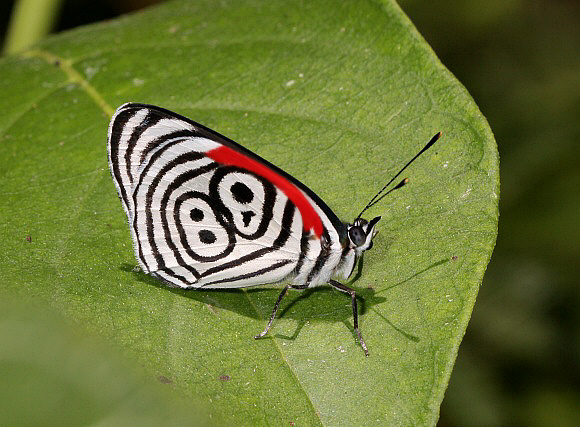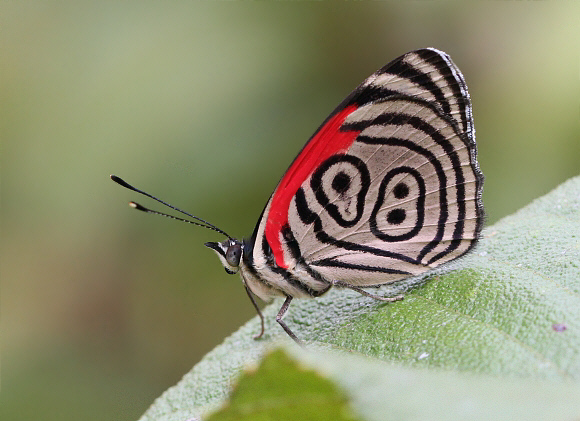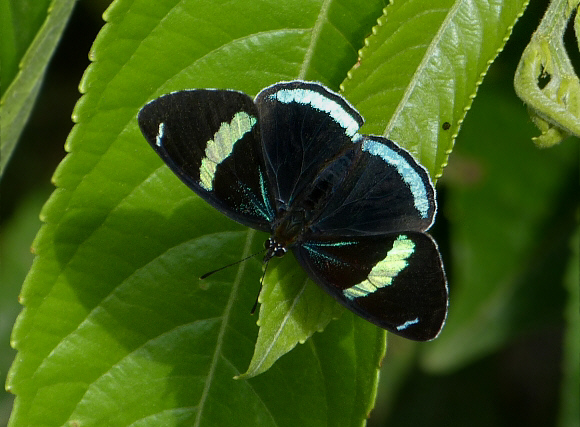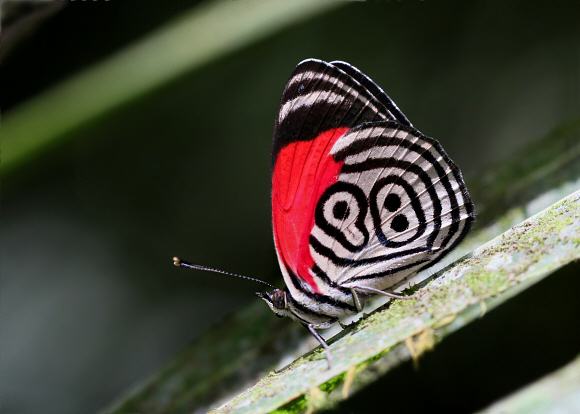 Diaethria clymena peruviana, Satipo, Peru – Adrian Hoskins
Diaethria clymena peruviana, Satipo, Peru – Adrian Hoskins
Introduction
The genus Diaethria is confined to Central and South America – 3 species are found in Mexico while the remainder are widely distributed across the Amazon and Andes. The butterflies often frequent human dwellings, and are considered a sign of good luck by some communities.
The uppersides of all Diaethria species are black, marked on the forewings with a diagonal band of metallic blue or green. In some species this colour is repeated on the hindwings in the form of a submarginal band.
The 89 or 88 numerals which appear on the underside hindwings of clymena are present in all 12 of the Diaethria species but vary in colour, thickness and shape. In clymena the lines are quite thick, and the markings often form an ’88’ figure, while in others such as neglecta and euclides they are thin and form an ’89’.
Diaethria clymena is quite variable in appearance – in some examples the black markings on the underside are thicker than those shown in the illustrations on this page. In several subspecies the black 89 markings are confluent with the innermost black submarginal line. The white ground colour of the hindwings often becomes dirty and brownish on older specimens, as illustrated below. There are 13 named subspecies distributed variously from Nicaragua to Brazil.
 Diaethria clymena marchalii, Tatama NP, Colombia – Adrian Hoskins
Diaethria clymena marchalii, Tatama NP, Colombia – Adrian Hoskins
Habitats
This species occurs at elevations between sea level and about 2000m, in rainforest and cloud-forest habitats where the larval foodplants Trema ( Ulmaceae ) grow.

Diaethria clymena peruviana, Satipo, Peru – Adrian Hoskins
Lifecycle
The eggs in common with those of other Diaethria species are whitish and highly sculptured. They are laid singly on the underside of leaves of Trema ( Ulmaceae ), close to the midrib. The larva is green, with a slightly roughened texture, and bears a pair of short spikes on the anal segment. The head bears a pair of very long whorled spines. The larva habitually rests on the upper surface of a leaf, with the thoracic segments raised and the head appressed to the substrate, causing the spines to project upward. If molested the larva twitches violently, swinging its head defensively from side to side to scare away predators or parasitoids. The chrysalis is suspended by the cremaster from a leaf or stem. It is green, with a dorsal keel, and projecting palpi.
 Diaethria clymena marchalii, Rio Claro, Colombia – Adrian Hoskins
Diaethria clymena marchalii, Rio Claro, Colombia – Adrian Hoskins
Adult behaviour
Both sexes are attracted to rotting fruit. The males are strongly attracted to urine-soaked sand, and also imbibe dissolved minerals from damp soil, road surfaces and rock faces. They are very active butterflies, easily disturbed, and rarely settle for more than a few seconds at a time in one spot, but they will return repeatedly to the same patch of ground.
They are usually seen in two’s or three’s, but sometimes congregate in large numbers at favoured spots. They are commonly found in the vicinity of human habitations, e.g. on river banks close to jetties, at places where laundry is washed, at ash covered ground at the site of campfires, and at urine-tainted patches of bare ground.
When not feeding, males perch on the upper surface of leaves at a height of about 2-3m, awaiting passing females. They also commonly perch facing head-downwards, on walls or tree trunks.
Just before sunset, males often bask with wings almost fully outspread, on the foliage of trees and bushes, before eventually retiring beneath a leaf where they spend the night, protected from rain.

Diaethria clymena marchalii, Rio Tambo, Peru – Adrian Hoskins
